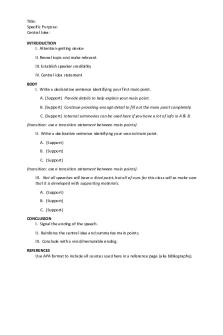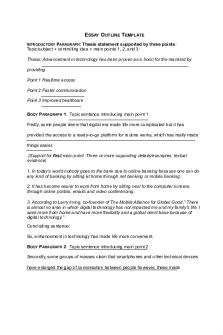Blank outline template PDF

| Title | Blank outline template |
|---|---|
| Author | Thomai Dunn |
| Course | Public Speaking |
| Institution | Bakersfield College |
| Pages | 2 |
| File Size | 139.8 KB |
| File Type | |
| Total Downloads | 89 |
| Total Views | 139 |
Summary
A blank outline template for speeches...
Description
**NOTE the number of main points, supporting, and sub-points can change depending on how you decide to present the information in your speech. A general guideline of the approximate number of points to make in a speech is 2-3 main points with at least 2 supporting points for each main point. All transitions must be complete sentences. Delete what is in italics and replace it with what you will use in your speech 3 outline components in percentages: Introduction (5-10%), Body (75-80%), Conclusion 10-15%) Sample Outline Format
Introduction I. Attention Getter Question, statistic, example, story, etc. to grab audiences’ attention and most importantly, their interest II. Thesis Statement A sentence with the all-encompassing statement of what your speech is specifically about. III. Preview of Main Points State your specific main points in 1 sentence. Transition: In 1 full sentence, provide an indication that you are done talking about your introduction/ preview of main points and are moving into your first main point. Body I.
Main Point One Write a sentence explaining what your first point is. A. Supporting point: 2-4 sentences long. Story, statistic, research, reference, etc. about first main point 1.Sub-Point 2-4 sentences long. Add supporting-points if needed these further explain, prove, or expand B. Sub- point 1. Supporting Point 2. Supporting Point C. Sub-point 1.Supporting Point Transition: In 1 full sentence, provide an indication that you are done talking about your first main point and are moving into your second main point, try to find the connection between ideas. II. Main Point Two. Write a sentence explaining what your second point is. A. Supporting point: 2-4 sentences long. Story, statistic, research, reference, etc. about second main point 1. Sub-Point 2-4 sentences long. Add sub-points if needed these further explain, prove, or expand B. Supporting point: 2-4 sentences long. Story, statistic, research, reference, etc. about second main point
1.Sub-Point 2-4 sentences long. Add sub-points if needed these further explain, prove, or expand 2. Sub-Point 2-4 sentences long. Add sub-points if needed these further explain, prove, or expand Transition: In 1 full sentence, provide an indication that you are done talking about your second main point and are moving into your third main point, try to find the connection between ideas. III.
Main Point Three Write a sentence explaining what your third point is. A. Supporting point: 2-4 sentences long. Story, statistic, research, reference, etc. about second main point 1. Sub-Point 2-4 sentences long. Add sub-points if needed these further explain, prove, or expand B. Supporting point: 2-4 sentences long. Story, statistic, research, reference, etc. about second main point 1.Sub-Point 2-4 sentences long. Add sub-points if needed these further explain, prove, or expand Transition: In 1 full sentence, provide an indication that you are done talking about your third main point/body of speech and are moving into your conclusion/review of main points. Conclusion I. Review of Main Points Restate your main points in 1 sentence II. Restate thesis statement III. Clincher / Closer Question, Story, Call to action, Quote, Example, Connect back to Attention-getter, etc. to have the audience keep thinking about your speech after you give it
Thank you...
Similar Free PDFs

Blank outline template
- 2 Pages

Blank Walden Template APA 7
- 6 Pages

Outline Template Saving Money
- 3 Pages

Project Outline Template
- 1 Pages

Outline template Online
- 1 Pages

Master Thesis Outline Template
- 1 Pages

Outline Spec- Template
- 24 Pages

Fahss - Course Outline Template
- 9 Pages

Essay Outline Template 12
- 2 Pages
Popular Institutions
- Tinajero National High School - Annex
- Politeknik Caltex Riau
- Yokohama City University
- SGT University
- University of Al-Qadisiyah
- Divine Word College of Vigan
- Techniek College Rotterdam
- Universidade de Santiago
- Universiti Teknologi MARA Cawangan Johor Kampus Pasir Gudang
- Poltekkes Kemenkes Yogyakarta
- Baguio City National High School
- Colegio san marcos
- preparatoria uno
- Centro de Bachillerato Tecnológico Industrial y de Servicios No. 107
- Dalian Maritime University
- Quang Trung Secondary School
- Colegio Tecnológico en Informática
- Corporación Regional de Educación Superior
- Grupo CEDVA
- Dar Al Uloom University
- Centro de Estudios Preuniversitarios de la Universidad Nacional de Ingeniería
- 上智大学
- Aakash International School, Nuna Majara
- San Felipe Neri Catholic School
- Kang Chiao International School - New Taipei City
- Misamis Occidental National High School
- Institución Educativa Escuela Normal Juan Ladrilleros
- Kolehiyo ng Pantukan
- Batanes State College
- Instituto Continental
- Sekolah Menengah Kejuruan Kesehatan Kaltara (Tarakan)
- Colegio de La Inmaculada Concepcion - Cebu






